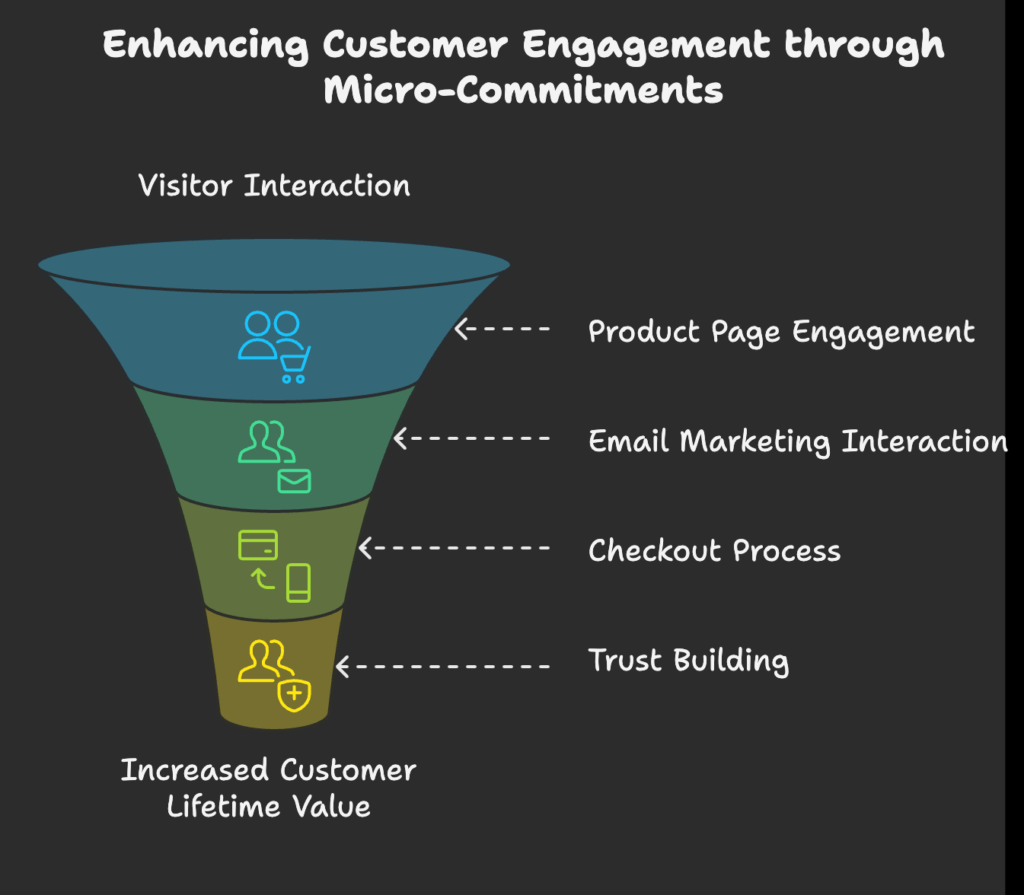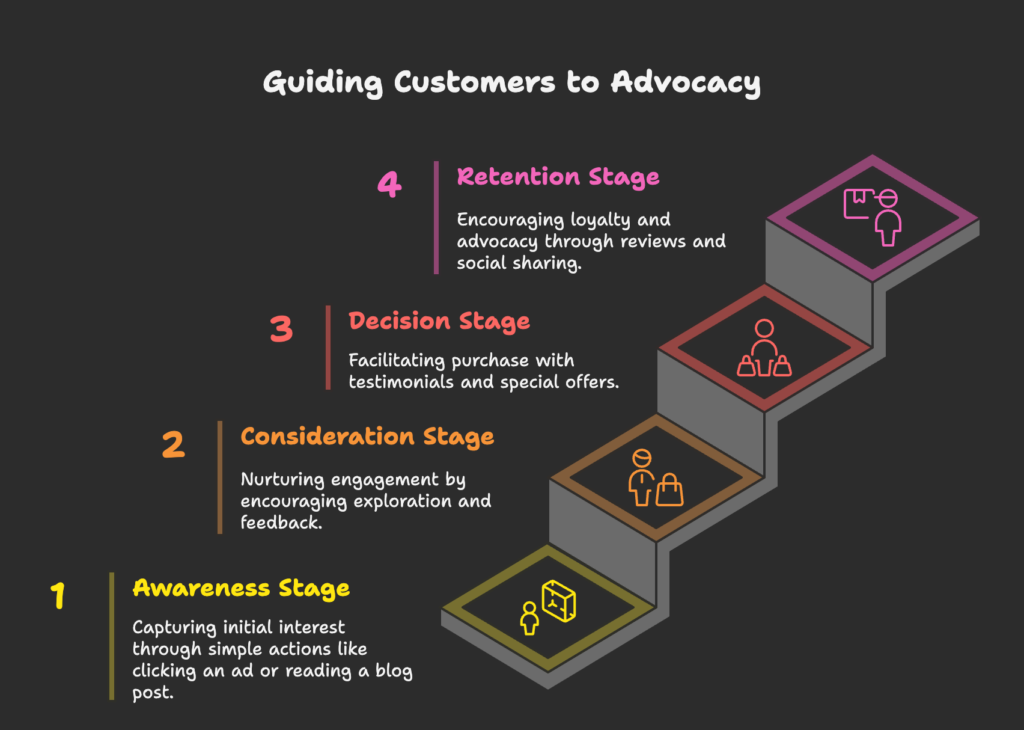Micro-commitments are small steps that encourage shoppers to take gradual actions before making a larger purchase decision. They can be as simple as clicking a product thumbnail or subscribing to a short email sequence. Each step builds trust, lowers resistance, and sets the foundation for deeper engagement. By guiding people through smaller requests, you create a comfortable path to bigger commitments.
The Psychology Behind Micro-Commitments
Micro-commitments build momentum because they often feel effortless. When a person completes a small action, they establish a sense of consistency. This positive feeling nudges them to say “yes” again, whether it’s providing an email address or checking out a new product line. With each step, the shopper’s brain associates small wins with your brand, making it easier for them to remain open to the next request.
Micro-Commitments vs. Traditional Conversion Strategies
Traditional conversion methods often rely on a single, high-stakes leap. In contrast, micro-commitments spread the journey into manageable steps. Instead of asking for a purchase right away, you might invite visitors to explore product features or browse a few personalized recommendations. By removing sudden pressure, you keep people engaged and curious.
The Role of Cognitive Dissonance in Micro-Commitments
Cognitive dissonance is the mental tension people feel when their actions conflict with their self-image. Micro-commitments reduce that tension. Each small action is easy to justify, so buyers remain aligned with the idea of moving forward. Over time, staying consistent with earlier actions becomes second nature, and the willingness to complete larger requests grows stronger.
The Importance of Micro-Commitments in the Shopify Ecosystem

How Micro-Commitments Align with Shopify’s Features
Shopify offers a wide range of user-friendly tools that lend themselves well to smaller actions. Easy-to-edit product pages, built-in email marketing, and straightforward checkout systems all help store owners create bite-sized steps. For instance, a Shopify store can showcase item reviews right below product images, encouraging shoppers to take a quick glance and then progress to more detailed interactions.
Benefits of Implementing Micro-Commitments on Shopify Stores
By integrating micro-commitments, you create a smoother funnel that keeps visitors engaged. This approach can result in:
- Higher Engagement: Frequent low-barrier interactions reduce bounce rates.
- Reduced Cart Abandonment: Small steps to confirm preferences or shipping details ease final purchase decisions.
- Stronger Trust: Gradual involvement fosters confidence in your brand.
Micro-Commitments and Customer Lifetime Value
When shoppers form a habit of taking small steps with your store, they often stay loyal longer. Rather than making a one-time purchase, they return for fresh recommendations, special offers, and product launches. This cycle directly boosts customer lifetime value, as each new commitment deepens their connection to your brand.
Case Studies of Successful Micro-Commitment Strategies on Shopify
Many Shopify entrepreneurs have seen measurable growth after using micro-commitment techniques. For instance, a fashion store might introduce a brief style quiz that helps visitors discover their best looks. Then, follow-up reminders bring people back to curated outfits. This repeated exposure builds familiarity and increases the chance of final conversions.
Implementing Micro-Commitments Across the Customer Journey

Awareness Stage: Capturing Initial Interest
At the beginning of the journey, your aim is to spark curiosity. Simple actions like clicking an ad or reading a blog post introduce your brand. You could also invite first-time visitors to watch a quick product demo. By keeping these requests small and easy, you open the door for deeper engagement.
Consideration Stage: Nurturing Engagement
Once shoppers show interest, encourage them to explore a bit more. Offer product comparisons, invite them to sign up for a waitlist, or ask for feedback on a single question. Each micro-commitment builds upon the trust gained in the awareness stage, making the transition toward purchase more natural.
Decision Stage: Facilitating Purchase
The decision stage benefits from micro-commitments that support final buying choices. One example is adding a short testimonial carousel on the product page. Another is providing a special discount code after a quick sign-up. Small steps here can help overcome last-minute hesitation, gently guiding users toward checkout.
Retention Stage: Encouraging Loyalty and Advocacy
After the sale, micro-commitments can turn casual buyers into brand advocates. Send an email prompting buyers to leave a brief review or share a photo of their purchase on social media. These quick actions remind them why they chose your store and inspire them to remain active participants in your community.
Micro-Commitment Strategies for Shopify Stores
Email Opt-ins and Newsletter Subscriptions
An email opt-in is a classic micro-commitment. It only requires an address and a click, but it grants you permission to nurture future sales. Consider offering a small perk, such as a free shipping code, to inspire that initial step.
Product Quizzes and Personalization Tools
Interactive quizzes gather details about a shopper’s needs, making them feel involved in shaping their experience. By answering a few questions, buyers get tailored suggestions that match their unique tastes. This personal touch can be the difference between a missed opportunity and a new sale.
Wishlist Creation and Social Sharing
Allow shoppers to save items for later with a single click. Encouraging them to share wishlists on social platforms is another lightweight step that spreads awareness. Both actions are easy to complete and maintain the sense of momentum.
Free Samples and Mini-Product Trials
Offering a small taste of your product can ease any lingering doubts. If you run a beauty store, consider sending a sample shade of a popular product. For digital goods, share a “preview” feature. These snippets build trust while reducing risk.
User-Generated Content and Reviews
Inviting customers to submit photos, videos, or short testimonials is a powerful micro-commitment strategy. It not only adds authenticity to your product pages but also celebrates your existing shoppers. When people see their own contributions on your site, they often feel more connected to your store.
Optimizing Shopify Pages for Micro-Commitments
Homepage Design for Initial Engagement
Your homepage can set the tone with a simple headline and a clear step to click. A prominent signup box or an invitation to view limited-time offers can move casual browsers along in seconds. Keep each request concise so visitors feel encouraged to proceed.
Product Page Strategies to Encourage Interaction
Layer your product pages with small actions that lead shoppers closer to checkout. Examples include:
- Short product videos to deepen understanding.
- Expandable details, so visitors can learn more without feeling overwhelmed.
- Quick questions to gauge preferred color or size.
Cart and Checkout Micro-Commitments
People often reconsider their choices at checkout. By adding reassurance—such as a “confirm your shipping address” prompt or a small note about an upcoming sale—you give them a chance to reinforce their decision. These subtle reminders encourage users to finalize their purchase.
Post-Purchase Micro-Commitments for Retention
After a successful sale, ask for a simple review or offer a straightforward upsell. For instance, a “Tell us how this product worked for you” button can keep the conversation going. Each small interaction strengthens the bond with your customers.
Leveraging Shopify Apps for Micro-Commitments
Review of Top Shopify Apps for Implementing Micro-Commitments
There are various Shopify apps that simplify micro-commitment tactics. Some focus on collecting reviews, while others specialize in quick pop-ups or email collection. Look for ones that integrate seamlessly with your theme, making sure they keep your store’s user experience smooth.
Custom App Development for Unique Micro-Commitment Strategies
If you have a niche product or service, you might benefit from a custom-built solution. A specialized app can let you experiment with targeted micro-commitments that resonate with your audience. Whether it’s one-click memberships or instant updates, custom development can bring fresh ideas to your strategy.
Integrating Micro-Commitments with Shopify’s Native Features
Shopify’s platform includes built-in features like discount codes, abandoned cart recovery, and automated email sequences. You can weave micro-commitments into these offerings by requiring just one or two clicks. This approach is especially helpful for streamlining your workflow and keeping things simple for shoppers.
Measuring the Impact of Micro-Commitments
Key Performance Indicators for Micro-Commitment Strategies
To see how well micro-commitments are working, keep track of:
- Opt-in Rate: How many visitors sign up for newsletters or offers.
- Click-Through Rate (CTR): The level of engagement with quizzes or pop-ups.
- Cart Abandonment Rate: Whether small nudges help reduce drop-offs.
- Repeat Purchase Rate: How often customers come back for more.
A/B Testing Micro-Commitment Tactics
Testing is key to refining your approach. Try different prompts or button placements to see which ones earn more clicks. Even changing a headline or altering the order of steps can have a noticeable impact on engagement.
Analytics Tools for Tracking Micro-Commitment Effectiveness
Google Analytics, Shopify’s built-in reports, and various third-party dashboards offer insights into user behavior. Watch where shoppers pause or exit. If you notice a drop-off at a specific step, tweak that element for a smoother path.
Calculating ROI on Micro-Commitment Implementations
Monitoring sales figures is crucial, but it’s also wise to factor in lifetime value and long-term loyalty. When multiple small actions turn into repeat sales, the financial gain can be substantial. Balancing setup costs and increased conversions helps you see the complete picture.
Advanced Micro-Commitment Techniques
Personalization and AI-Driven Micro-Commitments
AI can collect user data to predict individual preferences, presenting the most relevant micro-commitment at the right time. Whether it’s suggesting the next product in a series or changing homepage banners for return visitors, personalization keeps shoppers interested and reduces friction.
Gamification Strategies for Engaging Micro-Commitments
Reward points, badges, or short challenges can motivate people to interact with your store. These micro-commitments don’t feel like obligations. Instead, they create a sense of fun and competition, prompting shoppers to keep clicking and earning rewards.
Cross-Channel Micro-Commitment Campaigns
Combining strategies across email, social media, and onsite pop-ups can amplify results. A quick prompt on Instagram can funnel traffic to your store, where visitors encounter another small request, like signing up for a free guide. Each mini-step drives a sense of progression from one platform to the next.
Using Micro-Commitments in Retargeting and Abandoned Cart Recovery
Retargeting ads can remind shoppers of a simple action they can take to move forward. Maybe they left a specific item in their cart. A short prompt—like clicking to confirm their size—could bring them back. Each little nudge puts them closer to checking out.
Overcoming Challenges in Micro-Commitment Implementation
Balancing Micro-Commitments and User Experience
Bombarding shoppers with too many small requests can lead to frustration. Aim for a steady sequence of steps. Make each request relevant, keeping the process enjoyable rather than overwhelming.
Addressing Privacy Concerns in Data Collection
When you gather user data for personalization or quizzes, be transparent. Keep data requests minimal, and clearly explain how the information will help tailor the shopping experience. Respecting privacy goes a long way in building trust.
Avoiding Micro-Commitment Fatigue
While micro-commitments work well, too much repetition can dull the effect. Vary your requests and avoid making them feel routine. Add fresh calls to action and keep the sequence feeling natural so it maintains excitement.
Scaling Micro-Commitment Strategies for Growing Businesses
As your audience expands, watch for signs that your tactics need to adapt. The same strategies may not work for larger groups or international markets. Use analytics to fine-tune your approach, and consider local preferences if you serve different regions.
Future Trends in Micro-Commitments for Shopify
Emerging Technologies and Their Impact on Micro-Commitments
From augmented reality to voice assistants, new technologies offer novel ways to request small actions. Imagine letting shoppers virtually preview a product in their home before they move forward to checkout. These features may feel futuristic, but they mesh well with the short-step concept.
Predictive Analytics in Micro-Commitment Strategies
Data modeling can indicate when a shopper is ready for a specific type of micro-commitment. If someone frequently checks a particular product category, predictive analytics might automatically suggest related items. Each small suggestion is personalized, raising the odds of a positive response.
The Role of Voice Commerce in Micro-Commitments
As voice-activated devices become more common, voice prompts could ask shoppers to confirm a color choice or add an item to a wish list. These simple audio cues can guide customers forward without forcing them to navigate multiple screens.
Ethical Considerations and Best Practices for Future Implementation
Respect for user autonomy remains the guiding principle of any micro-commitment approach. Ensure your prompts feel helpful rather than pushy. Communicate the benefits clearly, and give shoppers an easy way to opt out at every step.
References
- Farrell, R. (2025). Touchpoints vs. Micro-Commitments: How Both Work Together to…. LinkedIn. https://www.linkedin.com/pulse/touchpoints-vs-micro-commitments-how-both-work-together-ryan-farrell-trafc
- Bice, B. (2020). The Value of Micro-Commitments. LinkedIn. https://www.linkedin.com/pulse/value-micro-commitments-bill-bice
- Wired Media. (2025). Micro-Commitments: A Step-by-Step Strategy for Driving More Website Leads and Sales. https://www.wiredmedia.co.uk/2025/01/09/micro-commitments-a-step-by-step-strategy-for-driving-more-website-leads-and-sales/
- Blue Sage Consulting. (2024). How to Implement Micro-Commitments for Influence and Leadership. https://www.bluesageconsulting.com/2024/04/08/implementing-micro-commitments-for-influence-and-leadership/
- XGen Tech. (2025). Guide to Shopify Microconversions for Health & Wellness Brands. https://xgentech.net/blogs/resources/shopify-microconversions-guide
Ready to supercharge your Shopify store’s sales with perfectly optimized discount codes? Growth Suite is a Shopify app that helps you do just that. Install it with a single click and start seeing results!




